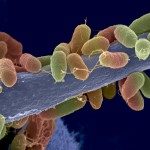Link to Pubmed [PMID] – 9988513
Med. Mycol. 1998;36 Suppl 1:238-48
Research on fungi that cause opportunistic infections has increased dramatically during the past few years, largely because these organisms cause significant morbidity and mortality. Most of this research has focused on defining the virulence factors produced by these pathogens, as well as developing methods for the diagnosis of fungal diseases. With regard to studies on the biology of Candida albicans, it is now possible to isolate genes, disrupt their expression, and observe the specific effects of gene disruption on virulence and growth of the organism. Moreover, growth and virulence of this pathogen is also being studied and the effect of environmental factors on gene expression investigated. This subject is especially important in view of the fact that C. albicans can colonize and invade a number of sites in the human body. Thus, its ability to grown in the oral and vaginal tracts, as well as in blood, requires the organism to adapt to a variety of environmental stresses. Here we present observations on the growth, morphogenesis and virulence of the opportunistic fungi C. albicans and Aspergillus fumigatus.

